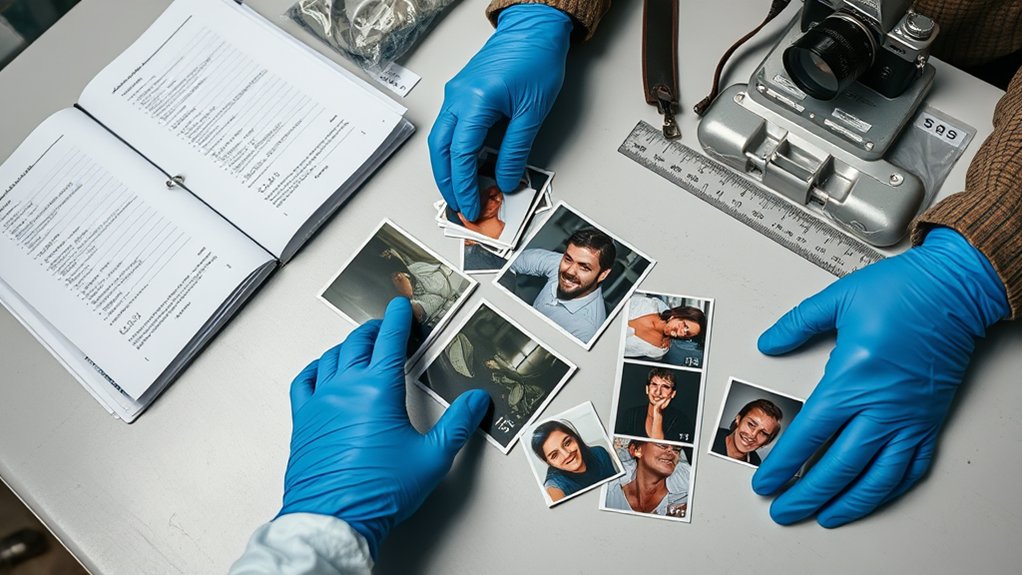Private investigators employ systematic documentation methods when investigating child abuse cases. Key protocols include maintaining detailed chronological records, conducting trauma-informed interviews, preserving physical and digital evidence, and ensuring proper chain of custody. All procedures must comply with state and federal requirements while protecting victim confidentiality. Professional investigators utilize standardized forms, photographs, and secure digital storage systems. Understanding these essential investigation techniques forms the foundation for building legally admissible cases.
Key Takeaways
- Implement trauma-informed interviewing techniques with child victims, using open-ended questions and documenting responses verbatim for court admissibility.
- Document physical evidence through sequential photographs, maintaining detailed chain of custody records and secure storage compliant with laws regarding minors.
- Establish formal partnerships with law enforcement and CPS early to minimize multiple interviews and enhance interagency collaboration.
- Utilize standardized forms and checklists for consistent documentation, including witness signatures and timestamps for evidence verification.
- Preserve digital communication records systematically, documenting threatening language or grooming behavior while adhering to legal surveillance requirements.
Legal Requirements and Case Standards

The investigation of child abuse cases requires strict adherence to legal protocols and established professional standards. Private investigators must maintain thorough documentation procedures that meet state and federal requirements while protecting the integrity of potential evidence. All investigative actions must be conducted within the scope of applicable laws and regulations.
Investigators must follow strict legal standards when gathering evidence, interviewing witnesses, and documenting findings. This includes obtaining proper authorizations, maintaining chain of custody records, and safeguarding confidentiality of all case materials. Reports must be detailed, objective, and free from speculation or personal bias. Photography, audio recordings, and written statements must comply with jurisdictional requirements and be properly authenticated. These standards help guarantee that collected evidence remains admissible in court proceedings while protecting the rights of all parties involved. Similar to infidelity cases, investigators should conduct thorough digital forensics analysis to uncover electronic evidence that may support allegations of abuse.
Interview Protocol for Child Witnesses
Interviewing child witnesses requires specialized training and strict adherence to established protocols that protect both the investigation and the child’s well-being. Investigators must implement a child-centered approach, ensuring interviews take place in age-appropriate settings with minimal distractions.
Trauma-informed techniques emphasize creating a safe, supportive environment where children can share their experiences without feeling pressured or judged. The protocol includes using open-ended questions, avoiding leading statements, and maintaining a neutral tone throughout the interview. Investigators document responses verbatim and employ developmentally appropriate communication methods.
Essential elements include conducting interviews at times when children are most alert, allowing breaks as needed, and having a qualified support person present when legally required. All sessions must be properly recorded and documented according to jurisdictional standards. Maintaining meticulous attention to detail during interviews helps build stronger custody cases that truly represent the child’s best interests.
Physical Evidence Collection Procedures
Physical evidence collection in child abuse investigations requires meticulous documentation through properly exposed photographs of injuries, environmental conditions, and relevant items at the scene. A detailed chain of custody record must track all physical evidence from initial collection through final storage or disposal, including timestamps, handler names, and transfer circumstances. Investigators must coordinate with medical professionals to properly obtain and preserve medical records, diagnostic images, and laboratory results according to applicable privacy laws and evidentiary requirements. Similar to infidelity cases, investigators focus on gathering admissible court evidence that can withstand legal scrutiny during proceedings.
Scene Photography Best Practices
Proper photographic documentation of potential child abuse scenes requires meticulous attention to established protocols and procedures. Professional investigators must systematically capture images that accurately represent the environment while following scene composition tips and implementing appropriate lighting techniques.
- Document the overall scene using wide-angle shots from multiple angles, establishing spatial relationships between objects and evidence locations
- Capture medium-range photographs highlighting specific areas of interest, including entry points and disturbed locations
- Take detailed close-up images of individual pieces of evidence with and without measurement scales
- Maintain a chronological photo log detailing each image’s number, location, subject matter, and relevant case information
Following these systematic photography protocols guarantees thorough scene documentation while maintaining evidence integrity and chain of custody requirements.
Chain of Custody Documentation
Maintaining unimpeachable chain of custody documentation represents a critical responsibility for investigators handling physical evidence in child abuse cases. Each item collected must be meticulously tracked from the moment of discovery through final disposition, with detailed records of every transfer and storage location.
Proper chain management requires investigators to document the date, time, location, and condition of evidence when collected. A standardized form must accompany each item, recording names and signatures of all personnel who handle the materials. Evidence storage facilities must maintain secure, climate-controlled environments with restricted access and logging procedures. Digital documentation systems can help track custody transfers while reducing manual errors. When evidence moves between agencies or to laboratories, certified shipping methods with tracking capabilities guarantee accountability and preserve admissibility in legal proceedings.
Medical Record Preservation
While chain of custody procedures safeguard physical evidence, medical records require distinct preservation protocols in child abuse investigations. The medical history importance in these cases cannot be overstated, as documented injuries and treatments often provide vital evidence for prosecution.
- Medical records must be obtained through proper legal channels, respecting health records confidentiality laws and HIPAA requirements
- Documentation should include complete chronological records from all healthcare providers who examined or treated the child
- Records must be stored in temperature-controlled environments to prevent deterioration, with digital backups maintained on secure servers
- Access logs must be maintained, tracking every instance of record retrieval or review by authorized personnel
Investigators should coordinate with healthcare facilities to guarantee proper preservation of original documents while maintaining their evidential integrity throughout the investigation process.
Digital Communication Records and Analysis

Digital communication records serve as critical evidence in child abuse investigations, encompassing text messages, emails, social media activity, and messaging app conversations. Investigators must implement proper data preservation protocols to capture and secure these digital footprints before they can be altered or deleted.
Communication analysis involves systematically reviewing message content, timestamps, frequency patterns, and emotional indicators within digital exchanges. Investigators document threatening language, grooming behavior, or explicit content that may indicate abuse. They also examine metadata to establish timelines and verify authenticity of communications.
Professional investigators utilize specialized software tools to extract, archive, and analyze digital communications while maintaining chain of custody. This guarantees that collected evidence remains admissible in legal proceedings and supports the investigation’s integrity through proper documentation and secure storage protocols. Licensed professionals are uniquely qualified to ensure all surveillance and evidence collection complies with applicable laws.
Surveillance Techniques in Child Safety Cases
Professional investigators employ surveillance techniques in child safety cases to gather evidence, monitor potential threats, and guarantee the protection of at-risk minors. These techniques combine traditional observational tactics with modern technology to create thorough monitoring systems.
- Covert operations utilize hidden cameras and video recording devices strategically placed in approved locations to document suspicious child interaction patterns.
- Advanced tracking software and surveillance drones provide real-time location data and movement analysis of persons of interest.
- Behavioral analysis experts review collected data to identify potential warning signs and establish patterns of concerning conduct.
- Digital monitoring systems integrate multiple surveillance streams for detailed data analysis, enabling investigators to build strong cases while maintaining strict privacy protocols and legal compliance.
Investigators must understand state law requirements when setting up surveillance equipment to avoid potential legal violations during evidence collection.
Coordinating With Law Enforcement and CPS
Effective coordination between private investigators and official agencies requires establishing formal partnerships with law enforcement and Child Protective Services (CPS) early in child abuse cases. Professional investigators must follow strict protocols when transferring evidence and documentation to authorities while maintaining proper chain of custody standards. Strategic collaboration helps minimize the need for multiple interviews of child victims, reducing potential trauma while ensuring all investigating parties obtain necessary information. The team’s licensed private investigators utilize specialized tools and resources to gather court-admissible evidence while maintaining the highest standards of confidentiality and professionalism.
Building Agency Partnerships
Successful child abuse investigations require coordinated partnerships between private investigators, law enforcement agencies, and Child Protective Services (CPS). Establishing formal partnership agreements and participating in collaborative training sessions strengthens these essential connections while ensuring all parties understand their roles and responsibilities.
Key elements for building effective agency partnerships include:
- Regular interagency meetings to discuss ongoing cases, share resources, and establish communication protocols
- Development of standardized reporting procedures and documentation requirements across organizations
- Cross-training opportunities focusing on interview techniques, evidence collection, and legal requirements
- Creation of rapid response protocols for emergency situations requiring immediate multi-agency involvement
These partnerships facilitate seamless information sharing, reduce duplication of efforts, and ultimately lead to more effective investigations that better serve vulnerable children.
Evidence Transfer Protocols
Chain of custody represents a critical component when transferring evidence between private investigators, law enforcement agencies, and Child Protective Services. Proper evidence handling procedures guarantee that documentation, photographs, and physical specimens maintain their legal validity throughout the investigation process.
Standardized transfer protocols require detailed documentation of each evidence exchange, including dates, times, locations, and personnel involved. Private investigators must utilize tamper-evident packaging, maintain secure storage conditions, and record any environmental factors that could affect evidence integrity. When transferring materials to law enforcement or CPS, investigators complete chain of custody forms that track the movement and possession of each item. These forms include signatures from all parties involved in the exchange, establishing an unbroken record of evidence handling from collection through final disposition.
Minimizing Interview Duplication
The coordination of interviews between private investigators, law enforcement, and Child Protective Services prevents unnecessary trauma to child abuse victims through repeated questioning. Proper interview techniques minimize psychological impact while maintaining investigative integrity through systematic collaboration.
- Agencies establish a designated lead interviewer to conduct primary questioning while other investigators observe through video monitoring systems
- Documentation sharing protocols enable agencies to access recorded statements, reducing the need for multiple interviews
- Joint interview planning sessions promote extensive coverage of essential topics without duplicating questions across agencies
- Multi-disciplinary team meetings facilitate information exchange and coordinate follow-up interviews only when new evidence requires clarification
This structured approach protects children from re-traumatization while promoting thorough documentation of abuse allegations across all investigating parties.
Documentation Methods and Chain of Custody

Maintaining accurate records through meticulous documentation represents a critical element in child abuse investigations. Investigators must adhere to documentation best practices, including detailed written reports, photographs, audio recordings, and thorough interview transcripts. All materials require proper labeling with dates, times, locations, and present individuals.
Evidence integrity standards necessitate a clear chain of custody record tracking each piece of evidence from collection through storage and analysis. This includes securing physical evidence in tamper-evident containers, maintaining detailed transfer logs, and storing materials in temperature-controlled environments. Digital files require encryption and backup systems with restricted access. Investigators should utilize standardized forms and checklists to guarantee consistent documentation procedures across cases, while maintaining separate files for each victim, witness, and suspect. Similar to cohabitation cases, licensed private investigators provide credible and admissible evidence that strengthens the legal validity of documentation in court proceedings.
Background Investigation Strategies
Building upon properly documented evidence, background investigations provide foundational context for child abuse cases. Investigators conduct extensive background screening procedures to establish patterns, identify potential risks, and uncover relevant historical information. These investigations require methodical approaches to gather and analyze data from multiple sources.
- Systematic review of public records, including criminal history, court documents, and prior child protective services involvement
- Thorough risk assessment of all adults with access to the child, including employment history and reference checks
- Analysis of social media presence, online activities, and digital footprints to identify concerning patterns
- Verification of educational records, medical history, and professional credentials of involved parties
This structured approach guarantees investigators develop a complete understanding of the environment and circumstances surrounding the case while maintaining professional objectivity. Claimant interviews are conducted to gather reliable testimonial evidence that supports the investigation’s findings and strengthens the case documentation.
Photographic and Video Evidence Guidelines
Professional documentation of photographic and video evidence plays a critical role in child abuse investigations. Investigators must follow strict photographic ethics protocols when gathering visual documentation, ensuring all images and recordings serve a legitimate investigative purpose while maintaining victim dignity and privacy.
All visual evidence requires secure video storage systems with controlled access and proper chain-of-custody documentation. Investigators should capture clear, well-lit images that accurately represent injuries, environmental conditions, or other relevant details. Each photograph or recording must include time stamps, location data, and case reference numbers.
Investigators should avoid any manipulative techniques or editing that could compromise evidence integrity. Multiple angles and contextual shots help establish spatial relationships, while close-up images document specific details. All visual documentation must comply with applicable laws and regulations regarding minor subjects.
Similar to preventing employee theft, establishing clear incident reporting protocols and conducting regular audits of visual evidence storage systems are essential for maintaining documentation integrity.
Expert Witness Testimony Preparation
Proper documentation of evidence chains plays a critical role in establishing expert witness credibility during child abuse trials. Investigators must maintain detailed chronological records of how evidence was collected, handled, stored, and analyzed to withstand scrutiny during court testimony. Expert witnesses should thoroughly review all case documentation and prepare clear explanations of investigative methodology that can be effectively communicated to judges and juries. Digital forensics techniques are essential for preserving electronic evidence that may be crucial in child abuse investigations.
Evidence Chain Documentation
Maintaining an unbroken chain of evidence is critical for child abuse investigations that may lead to expert witness testimony. Documentation accuracy must meet rigorous standards to guarantee evidence integrity throughout the investigation process.
- Each piece of evidence requires detailed logging with date, time, location, collector’s name, and specific handling procedures used during collection.
- Transfer documentation must track every individual who handles the evidence, including duration, purpose, and storage conditions.
- Photographic evidence needs sequential numbering, timestamp verification, and secure digital storage with backup systems.
- All documentation forms must include witness signatures, investigator certifications, and cross-referenced case numbers.
These standardized procedures protect evidence admissibility and strengthen the investigator’s credibility when testifying in court proceedings.
Building Credible Court Testimony
A private investigator’s court testimony requires meticulous preparation to establish and maintain credibility when serving as an expert witness in child abuse cases. Professional courtroom demeanor and thorough documentation greatly impact witness credibility during legal proceedings.
| Preparation Area | Key Elements | Critical Actions |
|---|---|---|
| Case Review | Documentation | Study case files thoroughly |
| Evidence | Chain of custody | Verify all documentation |
| Presentation | Professional attire | Conservative dress code |
| Communication | Clear responses | Practice concise answers |
| Demeanor | Composure | Maintain calm delivery |
Investigators must review all case materials, verify documentation accuracy, and practice delivering testimony clearly and confidently. Expert witnesses should anticipate cross-examination questions, maintain professional composure, and demonstrate thorough knowledge of investigative procedures and findings. Proper preparation guarantees testimony effectively supports the legal proceedings while maintaining investigative integrity.
Frequently Asked Questions
How Long Does a Typical Child Abuse Investigation Usually Take?
Investigation timelines vary considerably based on case complexity, ranging from several weeks to multiple months. Most investigations require 30-90 days to thoroughly gather evidence, conduct interviews, and complete documentation.
What Are the Success Rates for Private Investigators in Child Abuse Cases?
Success rates for private investigators vary greatly due to case complexities, with studies indicating 40-65% resolution rates when working alongside law enforcement and child protective services to document abuse cases.
Can Private Investigators Work Internationally on Child Abuse Documentation Cases?
Private investigators can operate internationally through cross border collaboration, but must comply with international laws and local jurisdictions. Many cases require partnering with licensed investigators in destination countries.
What Specific Training Certifications Are Required for Child Abuse Investigation Specialists?
Child abuse investigation specialists require specialized certification requirements including forensic interviewing, trauma-informed investigation techniques, legal documentation training, and relevant state/federal credentials through accredited law enforcement or social services programs.
How Much Do Private Investigation Services Cost for Child Abuse Documentation?
Private investigation costs vary based on multiple factors, with hourly rates ranging $75-200. Pricing structures typically include retainers, travel expenses, documentation fees, surveillance equipment, and expert testimony charges.
Conclusion
Proper documentation and evidence collection in child abuse investigations requires strict adherence to legal protocols, trauma-informed interview methods, and meticulous chain of custody practices. Success depends on thorough background investigation, secure preservation of physical and digital evidence, and careful photographic documentation. Expert testimony preparation must demonstrate methodical investigative processes while protecting victim privacy and maintaining case integrity for potential prosecution.






